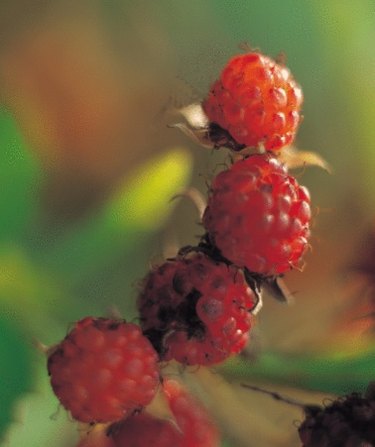Things You'll Need
Shovel or trowel
Organic materials for mulch
Ammonium nitrate fertilizer
10-10-10 fertilizer
Pruning tools

In Minnesota, home gardeners can grow raspberries throughout much of the state, the University of Minnesota Extension reports. However, to have successful raspberry bushes you need to understand how they grow. The bushes have perennial roots and crowns and also produce canes that live for two years. Primocanes are the new, year-old canes and appear green in color. The older, second-year canes are called floricanes and have a brown color. The second-year canes will die after bearing fruit and need to be pruned annually. However, some varieties, called everbearing raspberries, produce fruit on the primocanes.
Step 1
Identify a spot in your garden or yard that is suitable for raspberries. The plants need full sunlight and grow best in well-draining soil and in areas with good air circulation, the University of Minnesota Extension reports.
Video of the Day
Step 2
Plant young, disease-free raspberry plants according to the nursery directions in early spring. Spacing for raspberry bushes depends on the type. Black and purple raspberries need 4-foot spacing between plants with 8 feet between rows, according to the Minnesota extension. Red and yellow varieties require 2 to 3 feet between plants and at least 6 feet between rows.
Step 3
Water the plants regularly throughout the growing season. The bushes need 1 inch to 1½ inches of water weekly from spring until after the berries are harvested.
Step 4
Mulch around the bushes with organic material that is free of weed seeds, such as wood chips, wood shavings, leaves or grass clippings.
Step 5
Fertilize the plants for optimum growth. To start, apply a quarter-cup of ammonium nitrate to each plant as the primocanes begin to grow, the Minnesota extension suggests. Once your bushes become established, apply a 10-10-10 fertilizer each spring, before May 1. Always follow label directions for how much fertilizer to use and how to apply it.
Step 6
Weed the bed space regularly. If weeds become problematic, consider spreading a layer or mulch throughout the bed to discourage weeds if you have not done so already.
Step 7
Prune bushes annually to encourage vigorous growth. How and when to prune depends on the variety. For purple and black raspberries, pinch the primocane tips when they reach 24 to 30 inches and cut back fruit-bearing canes to ground level after harvest. For summer-bearing red and yellow raspberries, remove all fruit-bearing canes after harvest. Then, before new growth starts in the spring, cut primocanes back, taking care not to remove more than one-quarter of the length. If you want a fall harvest of red and yellow raspberries, cut all canes back to their bases in the spring before growth starts. If you want summer and fall harvests, prune as you would for the summer-bearing bushes. The primocanes that produced fall fruit should not be removed after harvest. Instead, cut them back to the last visible fruit-bearing node.
Step 8
Inspect the bushes for disease or pest infestation regularly and remove diseased, damaged, broken or weak canes.
Tip
The University of Minnesota recommends several cultivars for growth in the state. Recommended red raspberries with floricane fruiting include Latham, Festival, Encore, Boyne, Nova, Killarney, Haida, Prelude and K81-6. Red primocane fruiting varieties include Redwing, Polana, Caroline, Josephine, Heritage, Autumn Bliss, Autumn Britten, Double Delight and Red River. For yellow raspberries, try Fallgold or Anne for primocane-fruiting plants or Honeyqueen for floricane-fruiting plants. Recommended black raspberry cultivars include Bristol and Blackhawk, which both grow fruit on floricanes. For purple raspberries, plant Brandywine or Royalty, which also grow fruit on floricanes.
You can improve soil quality by mixing manure into your soil prior to planting, the Minnesota extension suggests. Use 3½ cubic feet of manure for every 100 square feet of garden space and thoroughly incorporate it into the existing soil.
Video of the Day